Slav Defense: The Complete Guide
Slav Defense is one of the best ways of dealing with the Queen’s Gambit with Black. It leads to solid positions with easy development and chances to play for a win. No wonder the Slav took a firm place in the repertoires of the best players in the world.
It is full of deep ideas and nuances, but don’t think it’s something unbelievably hard. The Slav defense is a great opening for beginners and intermediate players as well. Read further to see why!
Slav Defense: What is it?
The Slav Defense starts with the moves 1.d4 d5 2.c4 c6.
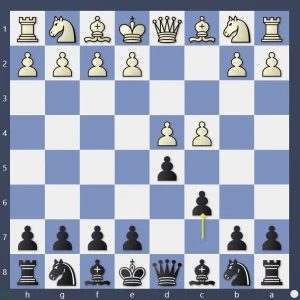
Black supports the center with a pawn and doesn’t block the road for the light-squared bishop. The Slav is one of the main defenses against the Queen’s Gambit.
History
The Slav Defense was known for more than 400 years but became popular only in the first half of the 20th century. For example, it was featured a lot in the World Championship match between Alexander Alekhine and Max Euwe in 1935.
Why is it called The Slav Defense? Some sources point out that initially, the name was The Czech Defense. Later, players from other Slavic countries employed this defense too, and the name was changed to give credit to Polish, Russian, and Yugoslavian players as well.
Why Play The Slav Defense?
The Slav Defense is a reliable opening that also offers chances to counterattack. Black’s play is schematic and easy to understand. Black gets much control over the center and easy development.
How To Play at Slav Defense for Black and White
Now let’s discuss the main plans for White and Black in the Slav Defense.
For Black
Black’s main idea is to develop the light-squared bishop to either f5 or g4 and then play pawn to e6. After that, Black can develop the dark-squared bishop to e7, d6, or b4 and castle. The basic scheme of development can be seen in the diagram below:
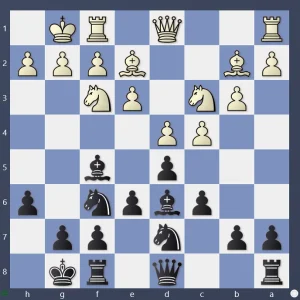
Black doesn’t have any bad pieces or weaknesses. The same scheme of development is the foundation of White’s play in the London System.
For White
White has several plans against the Slav Defense. The most common one is to go after Black’s light-squared bishop with Nh4. Another idea is to attack the b7-pawn with Qb3.
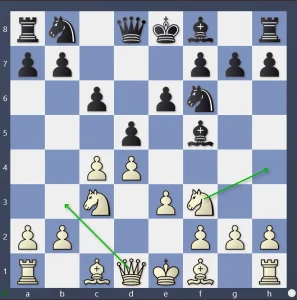
As you can see, White usually tries to exploit the drawbacks of Black’s early development of the light-squared bishop.
How to play Slav Defence: Popular Variations
Slav Defense: The Trap in the Main Line Variation
The main line of the Slav Defense starts with White developing both of their knights. 3.Nf3 Nf6 4.Nc3.
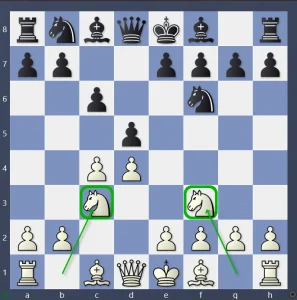
It is also often called the Three Knights Variation. Here Black should be careful. The most natural move 4…Bf5 can lead to a big advantage for White after 5.cxd5 cxd5 6.Qb3.
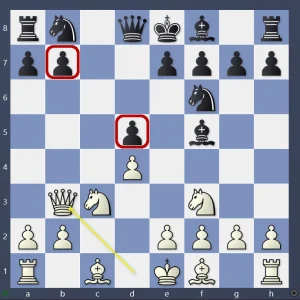
Now both pawns on b7 and d5 are targeted. The best defense for Black now is 6…Bc8, which looks depressing. A move 6…b6 would lose immediately to 7.e4 dxe5 8.Ne5, threatening Qxf7 and Bb5+ at the same time.
This line shows that Black should be careful with developing the light-squared bishop too early.
Slav Defense: Chebanenko Variation
One of the ways for Black is to play a waiting move 4…a6.
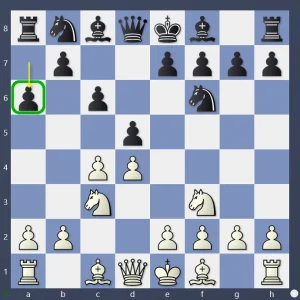
This move characterizes the Chebanenko Slav (also known as the Chameleon Slav Variation). The b7-pawn is no longer vulnerable – Qb3 will be met by …b7-b5 or …Ra8-Ra7. After 5.e3, Black can play 5…Bg4 or 5…Bf5. Still, the move 4…a6 doesn’t help Black much with development, so White has chances for an opening advantage.
Slav Defense: Classical Slav variation
More common is the move 4…dxc4. It starts the Classical Variation.
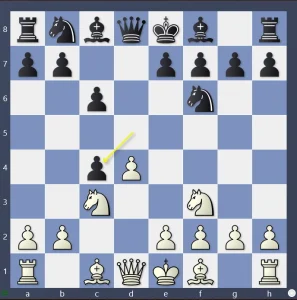
Black got an extra pawn and now is ready to protect it with …b7-b5. White’s main move is 5.a4, stopping Black’s plans. After 5…Bf5 6.e3 e6 7.Bxc4 Bb4 8.0-0 0-0, the following position arises:
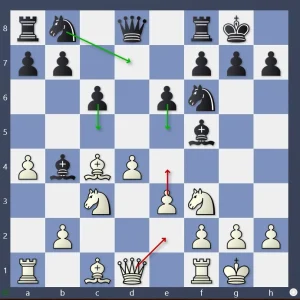
White’s main plan is to advance in the center with e3-e4, whereas Black’s ideas revolve around …c6-c5 and …e6-e5 breaks.
More ambitious for White is 6.Ne5.
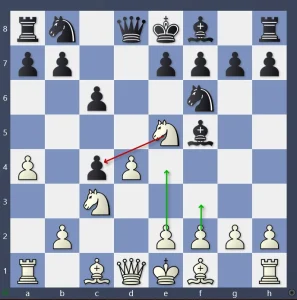
White is planning to take on c4 with the knight and build a powerful center with f2-f3 and e2-e4. This line requires more knowledge from Black, especially after the move 6…e6 (the Krause Attack). You can see an example below.
Slav Defense: Alekhine Variation
Instead of 5.a4, White can employ the Alekhine Variation with 5.e3.
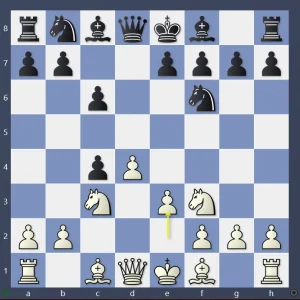
The game can continue with 5…b5 6.a4 b4 7.Na2 e6 8.Bxc4 Bb7 9.0-0 Nbd7.
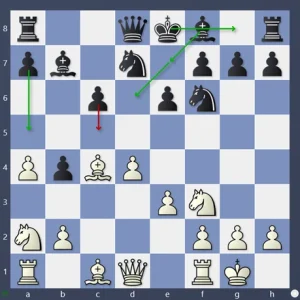
Black plans to complete development and open the position with the timely …c6-c5.
Slav Defense: Geller Gambit
White’s most aggressive option is 5.e4 – the Geller Gambit.
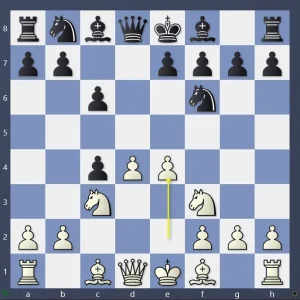
The move is risky. After 5…b5, White’s pawn on e4 becomes vulnerable because of the potential …b5-b4. Still, it has been played many times at the highest level. The main line goes 6.Be2 e6 7.0-0 Bb7.
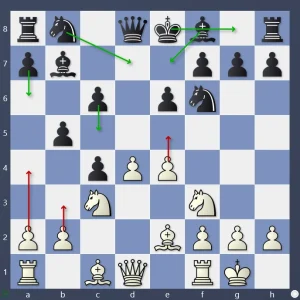
Black wants to complete the development and open the pieces with …c6-c5. White’s main ideas involve active moves such as a2-a4, b2-b3, and e4-e5. Black is up a pawn, but the chances are equal.
Slav Defense: Quiet Variation
If White wants to keep more control over the position, the Quiet Variation can be a good choice: 3.Nf3 Nf6 4.e3.
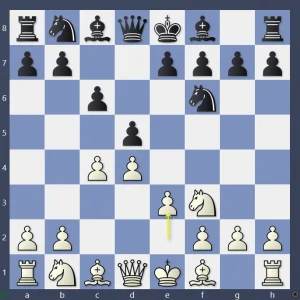
Now Black can develop the light-squared bishop to f5 or g4. In both cases, White’s main idea will be to attack it with the knight (Nh4) or the pawns (h3, g4). Black no longer can play the Classical Slav (4…dxc4 will be just followed by 5.Bc4), but it is still possible to transpose into the Chebanenko Slav (4…a6) or the Semi-Slav Variation (4…e6).
Below you can see a game from the World Championship match between Vladimir Kramnik and Veselin Topalov that featured the main line of the Quiet Variation.
Slav Defense: Modern Variation
Could Black take on c4 before White played e3? Yes, but it leads to different lines depending on which knight White develops on move 3. 3.Nf3 starts the Modern Variation.
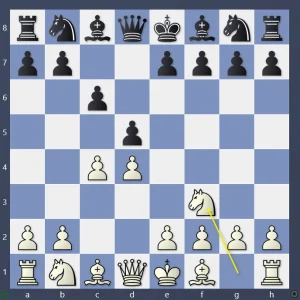
After 3…dxc4, the game can continue with 4.e3 b5 5.a4 Bb7 6.axb5 cxb5 7.b3! White gets the pawn back and retains some advantage.
Slav Defense: Slav Gambit, Alekhine Attack
If White starts with 3.Nc3, the move 3…dxc4 becomes stronger.
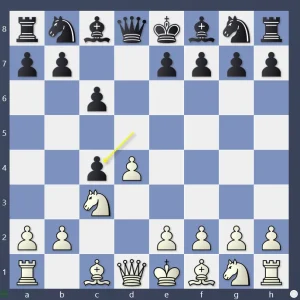
Now 4.e4 (the Alekhine Gambit) leads to wild positions. The main line goes 4…b5 5.a4 b4 6.Nb1 Ba6 7.Qc2 e5 8.Nf3 b3 9.Qc3 Nf6, etc.
The move 4.e3 is more solid. After 4…b5 5.a4 b4 6.Ne4 Qd5 7.Nd2 c3 8.bxc3 bxc3 9.Nb1 Qa5 10.Qc2, White has better chances.
Slav Defense: Semi-Slav variation
One of the most popular and solid variations of the Slav is the Semi-Slav. It is characterized by the move …e7-e6, blocking the bishop on c8. It is a mix of the Queen’s Gambit Declined and the Slav Defense.
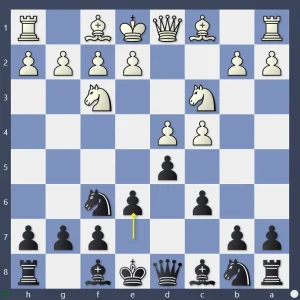
The Semi-Slav Variation looks solid but often leads to a sharp fight. White has two main moves: 5.Bg5 and 5.e3.
After 5.Bg5, Black has a choice. If you like calm play, choose 5…Nbd7 (the Cambridge Springs Variation). Sharp and complicated positions arise after 5…dxc4 (the Botvinnik Variation). Interesting is 5…h6, planning to continue with 6.Bh4 dxc4 (the Anti-Moscow Gambit). But White can go with 6.Bxf6 (the Moscow Variation).
5.e3 leads to the Meran Variation after 5…Nbd7 6.Bd3 dxc4 7.Bxc4 b5 8.Bd3.
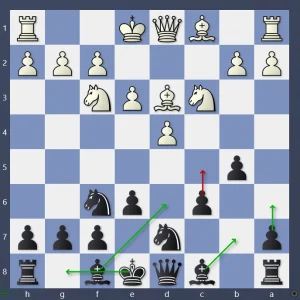
Black’s key idea is to open the pieces with the …c6-c5 pawn break. Below you can see an amazing game played by Viswanathan Anand in the Meran Variation.
Instead of 6.Bd3, White could play 6.Qc2 (the Anti-Meran Variation). In that case, Black can develop the dark-squared bishop to d6, knight to d7, castle, fianchetto the light-squared bishop, and look for counterplay in the center.
Slav Defense: Exchange Slav Variation
The Exchange Slav is characterized by the trade of the c-pawns in the center. It is often used by weaker players as an attempt to avoid theory or make a draw. Here is a typical position of the Exchange Slav Variation:
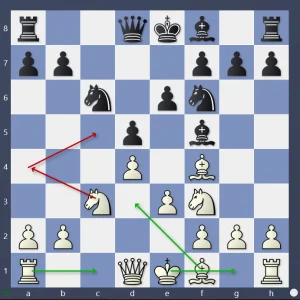
Both sides freely develop the pieces and try to exert pressure over the c-file. This variation is not as dull as it looks. There are many nuances and tricks both players can use from early on to defeat the opponent.
Slav Defense: Diemer Gambit
Let’s also see how to play against the Diemer Gambit of the Slav Defense. After 3.e4 dxe4 4.Nc3, Black has an easy way: 4…e5.
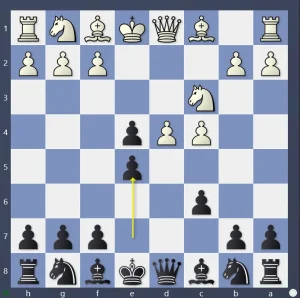
Black hits the center and leaves White in a bad endgame: 5.dxe5 Qxd1+ 6.Nxd1 Be6, followed by Nd7. Black is better. If White starts the gambit with 3.Nc3 Nf6 4.e4, Black can respond with 4…Nxe4.
Chess Courses about Slav Defense
Interested in learning all the nuances and intricacies of the Slav Defense?
Check out IM Marcin Sieciechowicz’s The Slav Defense Repertoire for Black based on the exciting Krause Attack. One of the best parts of the course is that every theoretical chapter is followed by game examples to give you a better understanding of the arising middlegame and endgame positions.
If you liked the Semi-Slav ideas more, you might enjoy IM Milovan Ratkovic’s Mastermind. This course will boost your understanding of the Semi-Slav Defense and armor you to fight the Queen’s Gambit with Black.
FAQ about Slav Defense
Is the Slav Defense good for beginners?
The Slav Defense is a great opening for beginners because it allows Black to control the center and develop pieces easily.
Who often plays the Slav Defense at the top level?
The Slav Defense was often played by Magnus Carlsen, Viswanathan Anand, Alexei Shirov, Fabiano Caruana, Wang Yue, Alexander Morozevich, Evgeny Bareev, Bu Xiangzhi, Ivan Sokolov, and many others.
I’m afraid of the exchanged variation, isn’t it too drawish?
It leads to symmetrical positions, but there is still plenty of game since all the pieces remain on the board. Both sides have many ideas and it can be interesting to play if you know what to do.
What is the most popular variation in the Slav Defense?
The most popular variations of the Slav Defense are the Semi-Slav Variation and the Classical Slav Variations. Both can be successfully played at any level.
I like the Slav, is there a similar opening against 1.e4 for Black?
Yes, the Caro-Kann Defense (1.e4 c6) is a similar opening to the Slav Defense.



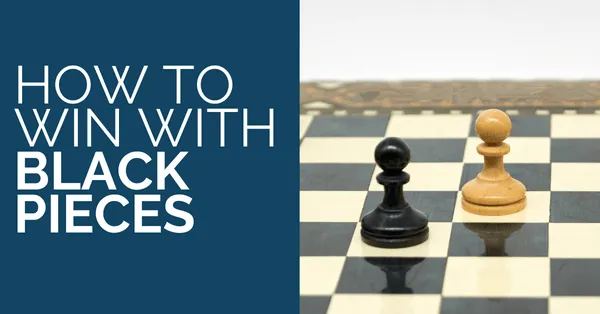
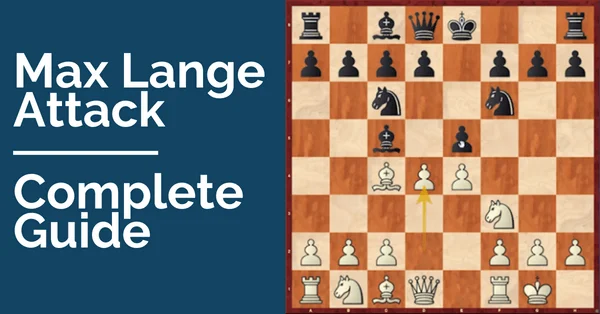
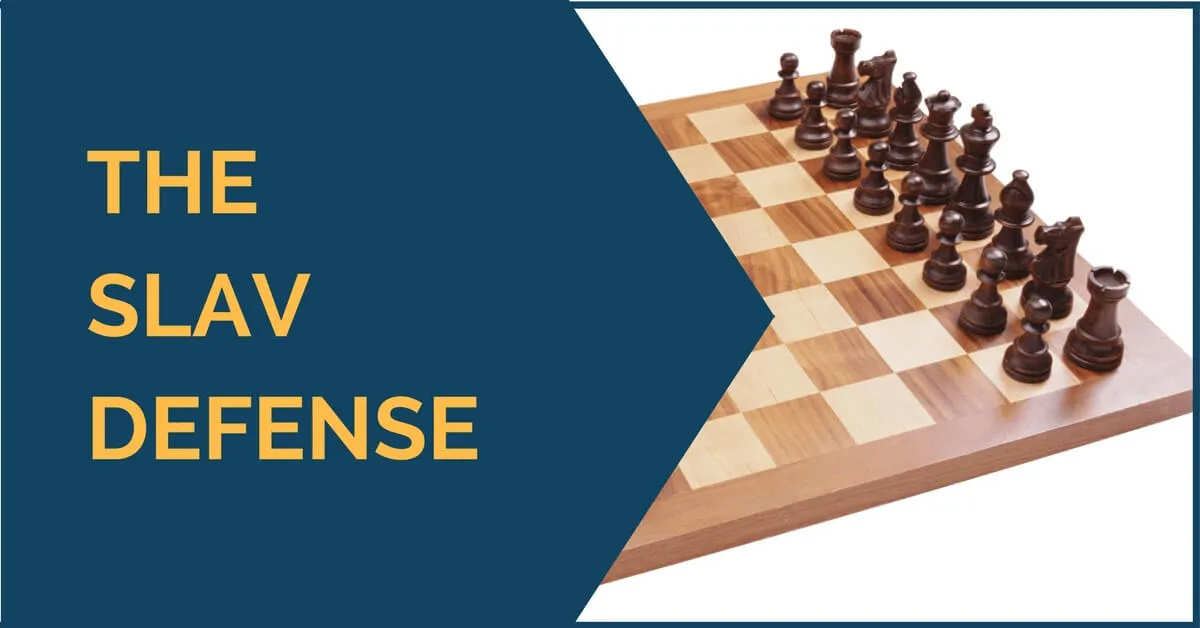




Comments: